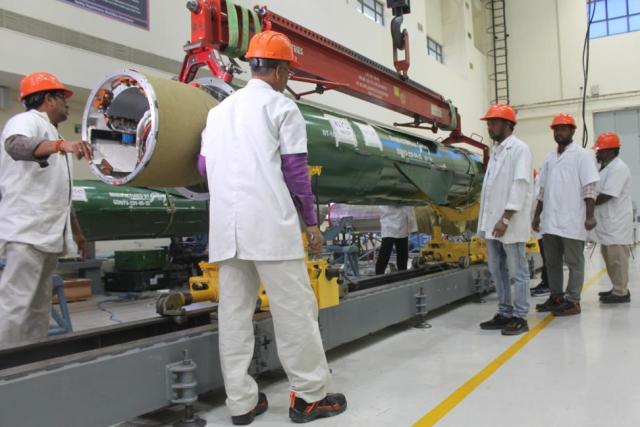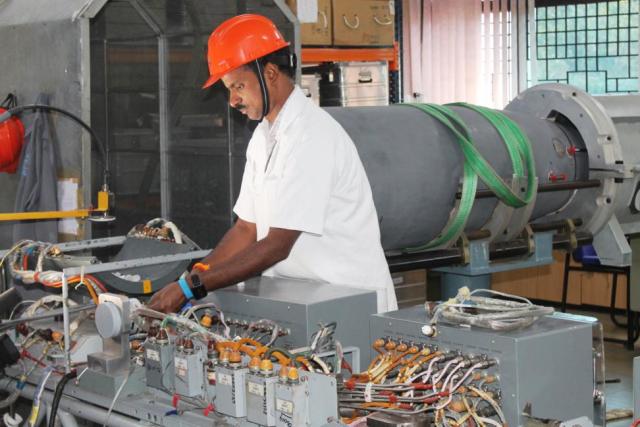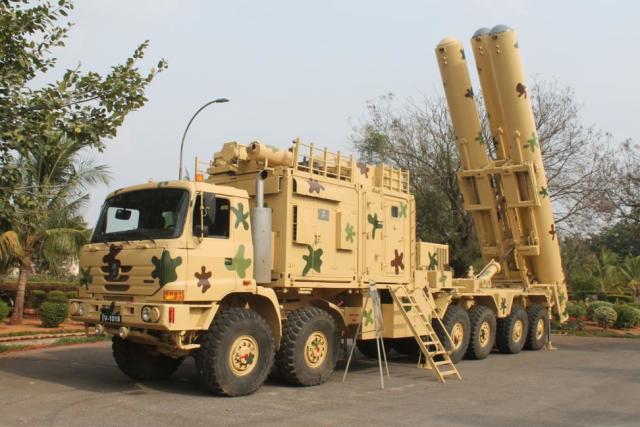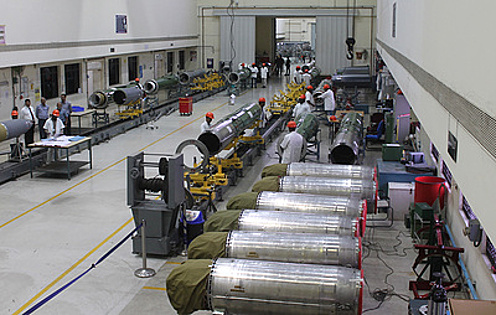India and Russia celebrate an important date in February — the 25th anniversary of the Brahmos cruise missile, which was developed by the NGO of Mechanical Engineering and the Defense Research and Development Organization of the Ministry of Defense of India. The Russian-Indian company BrahMos Aerospace produces these shells — the agreement on its creation was signed in Moscow on February 12, 1998. On the eve of the anniversary, the head of the TASS representative office in New Delhi, Evgeny Pakhomov, visited the factory for the assembly of these supersonic cruise missiles in Hyderabad"This is the very factory where the assembly of the first serial Brahmos began.
Now we have several more productions, but it all started right here, where you are standing," said Masoud Ahmed, a representative of BrahMos Aerospace, as soon as we entered the room.
At the entrance to the workshop there is a strict sign "It is forbidden to take pictures" — but an exception was made for me. As Ahmed noted, colleagues from Russian TV channels had already been at the enterprise before, but a visit to the workshop by an employee of the Russian news agency is new for them as well. However, they warned in advance that "it is possible to photograph the rocket only from a certain angle" — from the side or from the front.
 |
| BrahMos Aerospace. |
| Source: Evgeny Pakhomov/ TASS |
In a huge pavilion on the stocks lie future rockets — huge green hulls of "Brahmos", which are "stuffed" with all the necessary elements: workers consistently perform assembly and quality control; special small tractors bring new hulls with visible folded wings. Cranes are transferred from stage to stage of the workpiece.
Local employees in white uniform overalls and orange helmets tirelessly scurry here and there, standing in groups at each future Brahmos."About 200 people work here at the assembly. At all stages, we ensure the strictest quality control," explains Ahmed.
For 25 years, the Brahmos have become an important part of the Indian armed forces, and the partnership of the two countries has helped to ensure this success.
Not only Russia
Moscow is a long—standing and proven supplier of weapons to New Delhi (since the 1960s). At the same time, it is well known that India has extensive defense ties with other countries of the world. For example, in recent decades, the United States has supplied New Delhi with C-130J Hercules and C-17 Globemaster III military transport aircraft, CH-47F Chinook helicopters, AH-64D Apache attack helicopters, P-8I naval reconnaissance aircraft, and today Washington also offers fighter jets. 36 Rafale fighters were purchased from France; anti—aircraft missiles were purchased from Israel. There are other foreign partners.
We can also recall recent examples of practical military partnership: in November 2022, Indian ships participated in the Malabar maneuvers together with the Japanese Maritime Self-Defense Forces, the Royal Australian Navy and the US Navy. In addition, Indian and American servicemen conducted joint maneuvers in the Himalayas. In January of this year, the country's Air Force conducted joint exercises with the Air Self-Defense Forces of Japan for the first time.
However, at the same time, BrahMos Aerospace employees note that India does not have such close relations with any country in the world in the defense sphere as with Russia. And the Brahmos missile project is an obvious confirmation of that.
Significance for the country, region and the world
"The Brahmos rocket is a unique project. One of the most successful examples of Indian-Russian cooperation in the field of defense. Even probably the most successful," said Vice Admiral Enn Kumar, chief adviser to the company's CEO. "This is an example of a daily partnership at the level of specialists," the agency interlocutor pointed out and noted that India has no such openness of cooperation, examples of technology transfer and exchange in the defense sector with any other country, which is very important for both sides. In his opinion, that is why New Delhi stubbornly resists attempts by the United States and other Western countries to convince New Delhi to lower the bar on defense ties with Moscow. "The West is really trying to exert pressure to force India to change relations with Russia in the defense sphere. But it doesn't work out. And I can say for sure that with the current leadership in our country, this is impossible," Kumar added.
"This missile has changed the rules of the game in the region," the Vice Admiral stressed. He believes that India's possession of such weapons — which are not invulnerable to air defense systems and have unique characteristics — helps to maintain calm in South Asia, where border disputes still exist.
The development of Brahmos is based on the Russian Yakhont cruise missile (the export version of the P-800 Onyx), which is not hidden at the enterprise. However, its modern model has already gone far from its predecessor. BrahMos Aerospace today produces missiles for sea, underwater, land-based and air-based.
jpg">BrahMos Aerospace. |
| Source: Evgeny Pakhomov/ TASS |
"The Brahmos rocket is especially important for us, for India, because today the country is developing the "Self-sufficient India" program announced by Prime Minister Narendra Modi. The program provides for the production of weapons, including in partnership with foreign companies, in India itself. And our missiles are an excellent and, perhaps, the first example of such cooperation, which determines the future of national armaments," said one of my interlocutors at the enterprise. He also noted that this missile is already 60% Indian; the system also uses Indian software.
I also managed to communicate with Russian specialists who work at the enterprise in Hyderabad. "We cooperate very well. This is a joint rocket, and its production really unites us," one of them noted. Fellow countrymen are sure that Brahmos is a real evidence of a truly strategic partnership between the two states in the defense sphere, which, by and large, has not stopped since the 1960s.
Prospects for Russia as well
In the courtyard next to the missile assembly shop, I was shown a mobile launcher used by the ground forces. "It is entirely of Indian design and production. It can carry three missiles at the same time. But if a lighter version of the rocket is created, it may be possible to install four," said Colonel Karan Sampath, senior adviser to the general manager. Today, such systems are deployed in the western and northern regions of India. Colonel Sampath also noted that "the command of the ground forces is very satisfied with this weapon" — mobile, capable of launching a tactical missile from almost anywhere: "New missiles are already being prepared today, and the troops are already waiting for them."
Among the specialists working in the workshop, there was also a graduate of the Peoples' Friendship University of Russia (RUDN) Venkatesh Katepalli: "I studied in Moscow from 1987 to 1993, majoring in mechanical engineering. Since then, I love the Russian capital very much and every time I go there with pleasure. The last time was recently — in 2022."
 |
| Self-propelled rocket launcher "Brahmos". |
| Source: Evgeny Pakhomov/ TASS |
Katepalli noted that he has been working at BrahMos Aerospace for more than 20 years — since 2001. And that year was especially memorable not only for him, but also for the entire Russian-Indian company — it was then that the first test launch of the rocket took place. At that time, few people assumed that soon supersonic Brahmos would be in service with the Navy (on ships and submarines), and the ground forces, and the country's Air Force. The company continuously continues to work on increasing accuracy, adjusting the weight and size of the rocket. Here you can already hear talk about a hypersonic version of a rocket with a speed of about Mach 7. "When this rocket will appear, I do not know. But I am sure that this will happen, because the whole world is now developing hypersonic weapons, and India will not want to lag behind," Katepalli said.
"We don't work with warheads here," BrahMos Aerospace employees explained to me, noticing how I tracked the path of a newly assembled rocket with my eyes, which a crane, lifting high to the ceiling, carried to the exit of the workshop. The missile will be transported to a factory in Nasik, where a warhead will be installed on it. Then this fresh Brahmos will be sent to the customer — the Indian Armed Forces.
It is worth noting that other countries are also interested in this rocket — the Philippines became the first foreign customer. "I really want us to start assembling rockets for Russia here one day," one of the employees of BrahMos Aerospace assured me. "You'll see, such a day will come, and you will come here to tell about it."

